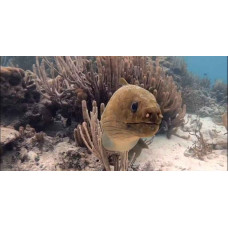Latin name
Gymnothorax funebris
Other names
Green Moray Eel
Identification
The body of a typical moray eel is flattened from the sides, the pectoral fins are absent, and the scaleless skin is thick and leathery. The dorsal and anal fins are low, sometimes almost hidden by the wrinkled skin around them. The gill orifice is small and round, and the teeth are large. The green moray eel has an unusual brownish-green color due to the yellow mucus covering the blue body of the eel.
Distribution
The green moray is found in the tropical and subtropical waters of North and South America.
Habitat
Moray eels live mostly on coral reefs or similar rocky places. A moray eel clings to corals and rocks with its back half of its body, allowing its front half to sway with the current. In this position, with its mouth open, it is ready to grab any prey that approaches. This gaping pose seems threatening, but this adaptation is not only suitable for prey, but also for breathing, allowing the eel to pump water through its gills. The green moray eel lives in coral reefs, sometimes going deep in finding of food.
Size
Most morays are large, reaching a length of 5-6 feet. Some reach a length of 10 feet. The green moray reaches an average length of 5-6 feet.
Life history and Behavior
Normally, moray eels are nocturnal, but they never miss an opportunity to emerge from their rocky lair when they have the urge to eat.
Food and feeding habits
They feed on small fish, octopus, crustaceans, mollusks.
Reproduction
No information
Interesting facts
If disturbed, a moray eel can seriously injure you. While this does not happen too often, it is not recommended to tease the moray eel on purpose. Do not put your unprotected hands in different burrows — there may be predatory fish with sharp teeth in there that won't like it. Previously, it was believed that these fish were poisonous. However, this has not been confirmed as they have not found glands capable of producing poison.
| Classification | |
| Phylum | Chordata |
| Class | Actinopterygii |
| Squad | Anguilliformes |
| Family | Muraenidae |
| Genus | Gymnothorax |
| Species | G. funebris |
| Features | |
| Conservation status | Least Concern |
| Habitat | bottom |
| Life span, years | 10 |
| Maximum body weight, kg | 29 |
| Maximum length, cm | 250 |
| Sailing speed, m/s | No information |
| Threat to people | Edible |
| Way of eating | predator |




